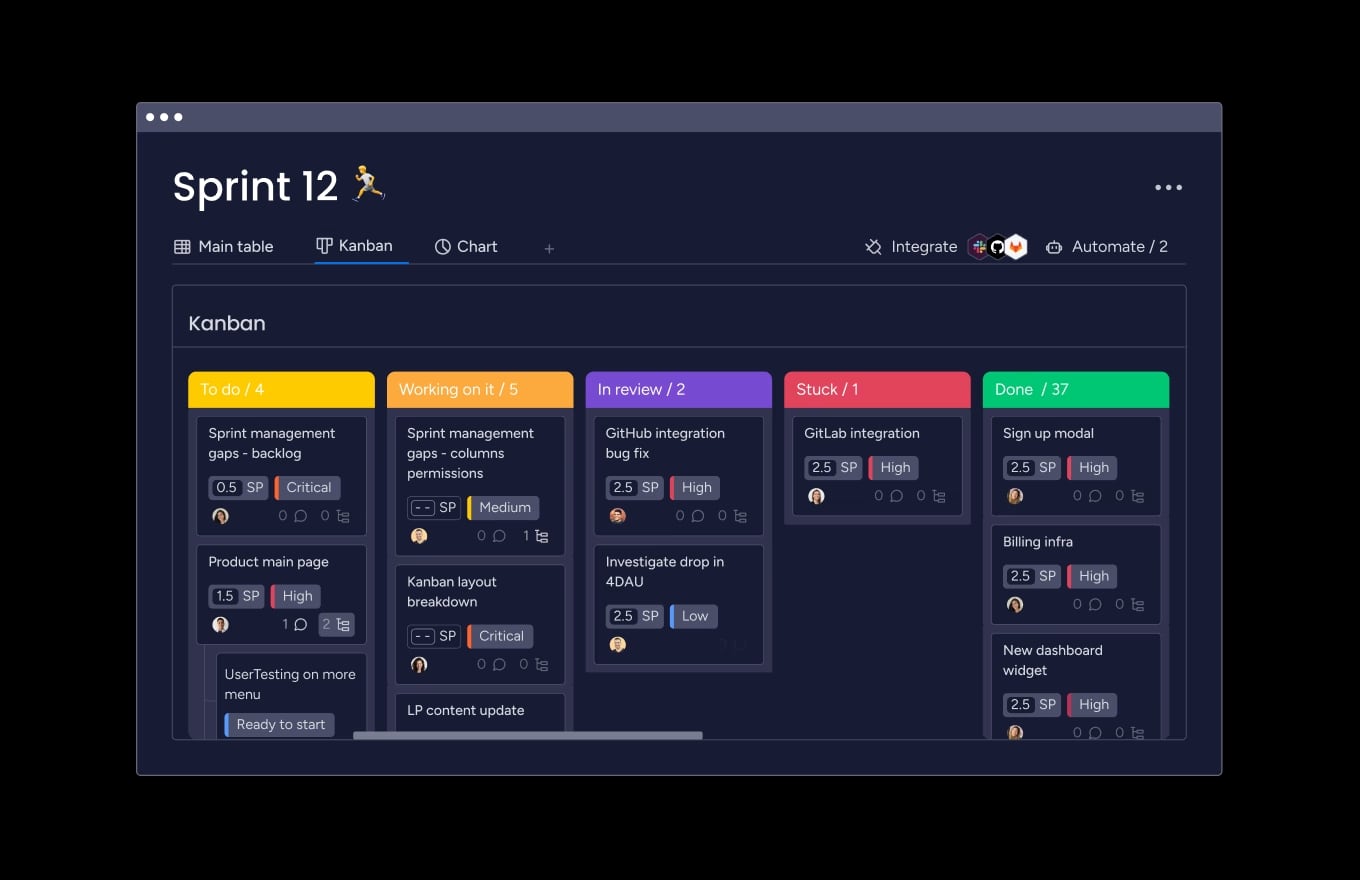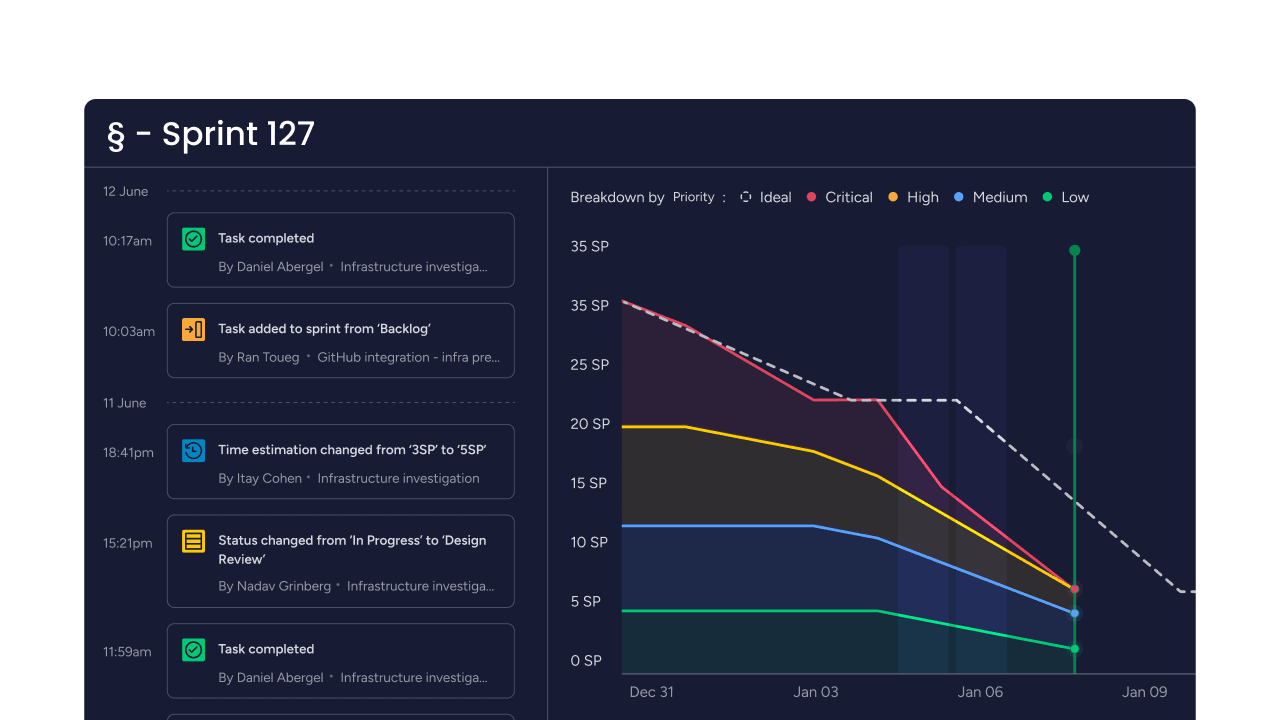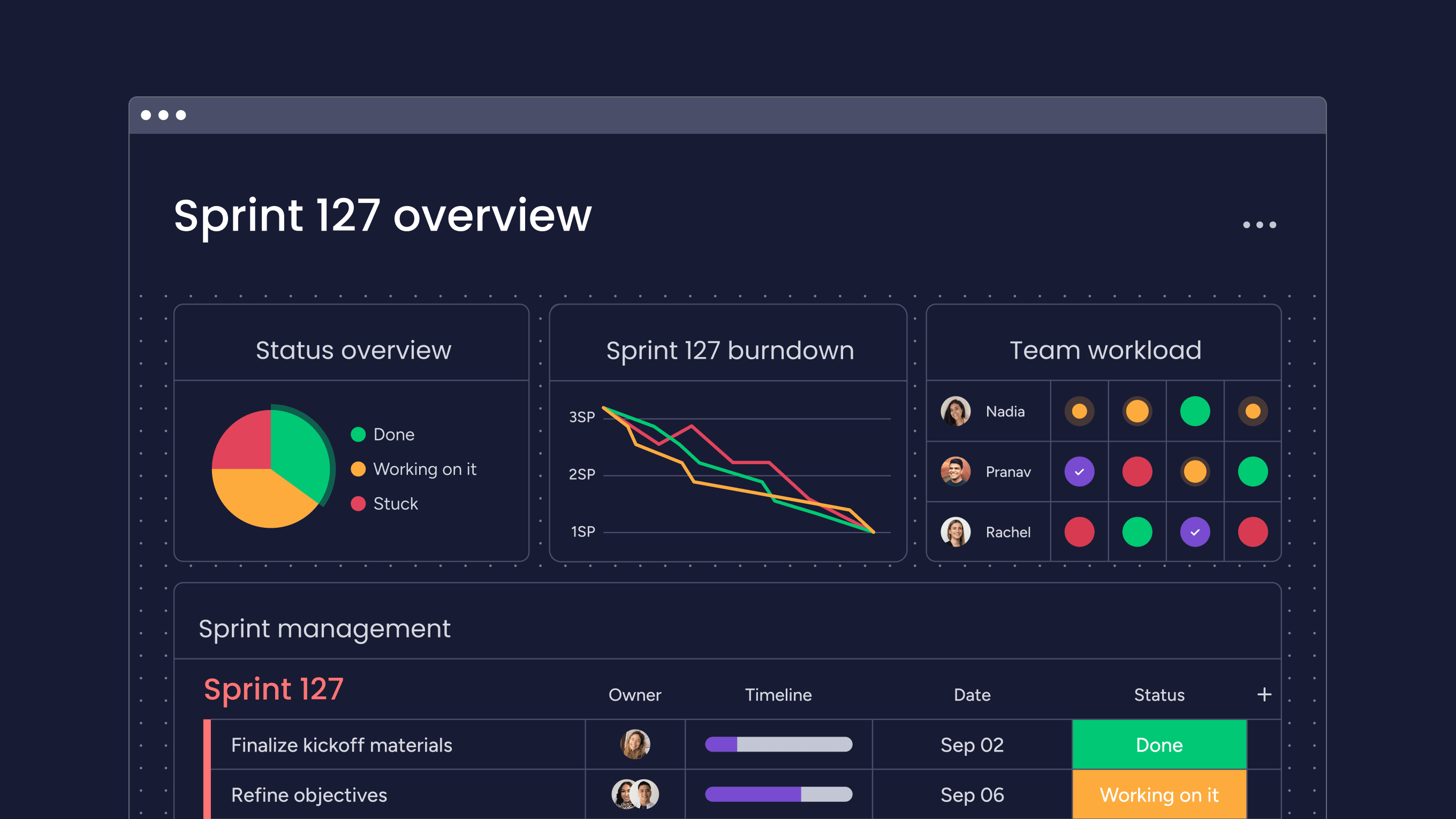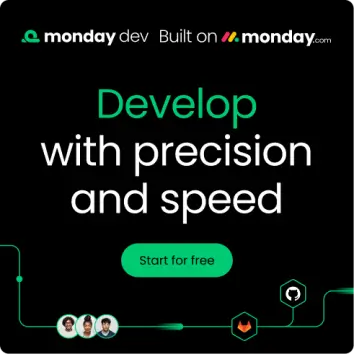When customer needs shift and markets move faster than your roadmap, rigid plans stop working, leading to costly delays and products that miss the mark. Agile product management solves this foundational challenge.
It’s a strategic philosophy and set of practices that help teams deliver value continuously by breaking down large goals into short, iterative cycles, baking in constant user feedback, and adjusting priorities in real-time. This dynamic approach ensures your development efforts always align with the highest-value opportunities.
In this comprehensive guide, you’ll learn exactly what Agile product management is and how its adaptive principles differ fundamentally from traditional methods. We will also shine a light on 15 core practices that help product teams move faster, stay aligned across the business, and consistently ship high-quality features customers actually want and need.

"monday dev empowered us to optimize our GTM approach, resulting in faster, more dependable deliveries"
Steven Hamrell | Director of Product Management
"monday dev empowers us to manage the entire development process on one platform so we can speed up product delivery and improve customer satisfaction"
Mitchel Hudson | Head of Technology
"We're operating in an open, deep trusting, transparent environment with no silos of information. It's about completely opening access to everyone who needs it."
Alan Schmoll | Executive Vice President, Vistra PlatformKey takeaways
- Iterative delivery over long cycles: deliver working software in one to four week cycles with constant user feedback, reducing time-to-market and product risk compared to traditional waterfall approaches.
- Customer-centric focus over pure output: focus on 15 core practices like customer discovery, dynamic backlog prioritization, and data-driven decisions to build products users actually want and need.
- Outcomes over velocity: measure success through customer satisfaction scores, feature adoption rates, and business impact metrics rather than just tracking team velocity or output.
- Collaboration over silos: build high-performance teams by defining clear roles, fostering cross-functional collaboration, and embracing continuous improvement through regular retrospectives and feedback loops.
- Platform flexibility over rigid processes: dedicated platforms like monday dev support your team’s agile practices through customizable workflows, AI-powered insights, and seamless integrations without forcing rigid templates or processes.
What is Agile product management?
Agile product management is a flexible approach that emphasizes short-term goals, constant iteration, and regular user feedback. Unlike traditional project management approaches with their extensive upfront planning and waterfall development cycles, Agile operates through iterative sprints. Product managers work closely with development teams, participating in daily stand-ups, sprint planning sessions, and regular retrospectives to ensure alignment between business objectives and technical execution.
Core principles of Agile product management
These principles translate Agile values into daily product management decisions and team interactions:
- Customer collaboration over contract negotiation: stay in ongoing dialogue with users to understand evolving needs.
- Responding to change over following a plan: pivot quickly when priorities shift.
- Working software over comprehensive documentation: deliver functional products users can test.
- Individuals and interactions over processes and platforms: team collaboration drives outcomes more than rigid methodologies.
Agile product manager vs traditional product manager
Agile product managers engage in daily collaboration with development teams and make decisions based on real-time feedback. Agile product managers work iteratively — setting shorter planning horizons and refining priorities each sprint.
On the other hand, traditional product managers often create comprehensive requirements documents before development begins. They work with quarterly planning cycles and less frequent team interactions.

How Agile product management drives success
Agile product management transforms how organizations deliver value. For leadership teams, this means reduced time-to-market and the ability to pivot quickly when business conditions change.
Agile minimizes risk by turning long-term guesses into short, testable learning cycles. Instead of betting everything on a single product vision, you test assumptions early and course-correct before investing significant resources.
Key benefits for modern organizations
- Faster time-to-market: launch products in weeks rather than months.
- Reduced product risk: identify potential issues before they become costly mistakes.
- Enhanced customer satisfaction: products evolve to meet actual user needs.
- Improved team alignment: cross-functional collaboration reduces miscommunication.
- AI-assisted visibility: real-time insights and automated reporting make it easier to track progress and forecast outcomes.
Impact on speed and innovation
Agile practices create safe environments for experimentation. Teams launch minimum viable products, gather real user data, and iterate rapidly based on what they learn.
This innovation cycle thrives on flexible Agile workflows that adapt to changing requirements. You can reorganize backlogs, adjust sprint priorities, and maintain visibility across all stakeholders without disrupting development rhythm — capabilities that solutions like monday dev are built to support.
15 essential Agile product management practices
Agile product management is about creating continuous value, not just managing a backlog. These 15 practices help teams stay focused, adaptive, and aligned as they deliver products in fast-moving environments.
Each one addresses a common challenge — from discovery and prioritization to delivery and learning — and together they form a complete approach to building better products through iteration, data, and collaboration.
1. Customer-centric product discovery
Product discovery means continuously understanding customer problems before committing development resources. Conduct ongoing customer interviews, user testing sessions, and market validation activities throughout the product lifecycle.
Combine analytics with real customer observation to reveal unmet needs. Observe how customers use products, understand their workflows, and identify pain points that usage data might miss.
2. Adaptive backlog prioritization
Your product backlog serves as the single source of truth for all potential work items.
- Balance work types: manage new features, technical debt, bug fixes, and strategic initiatives while maintaining focus on customer value.
- Use value-based scoring: employ Agile estimation techniques like the MoSCoW method or value-based scoring that considers customer impact, business value, and implementation effort.
3. Effective sprint planning
Sprint planning transforms backlog items into actionable work for time-boxed iterations. Collaborate with developers, designers, and stakeholders to ensure realistic commitments.
Focus on outcomes rather than outputs. Define what success looks like for users and how you’ll measure progress.
4. Continuous stakeholder engagement
Keep executives, sales teams, and other departments informed through ongoing communication. Regular demo sessions and transparent reporting maintain stakeholder buy-in.
When stakeholders understand priority changes and see tangible progress, they support the Agile approach more readily.
5. Data-driven decision making
Focus on actionable metrics rather than vanity metrics. Track user engagement, conversion rates, and feature adoption that directly relate to business outcomes.
Create feedback loops that inform future decisions. When you see how changes affect user behavior, you make more informed choices about what to build next.
6. Adaptive product roadmapping
Agile roadmaps focus on themes and outcomes rather than specific features and dates. This provides direction while maintaining flexibility.
Quarterly planning cycles function as a form of Agile release planning, allowing meaningful progress while remaining responsive to change. Roadmaps should communicate strategic intent and guide daily prioritization decisions.
7. Cross-functional team alignment
Tight collaboration between product, engineering, design, and marketing requires shared understanding of goals and success criteria. Regular alignment meetings and collaborative planning sessions maintain this coordination.
When everyone understands how their work contributes to objectives, teams move faster and make autonomous decisions.
8. Rapid MVP development
Minimum viable products test core assumptions with minimal investment. Identify the smallest feature set that validates key hypotheses about customer needs.
Design MVPs for learning. Set clear success criteria and measurement plans before building anything.
9. Real-time feedback integration
Gather feedback through in-app mechanisms, user testing, support insights, and analytics. The challenge is synthesizing this information into actionable insights.
Smart software like monday dev help teams collect and act on feedback quickly through integrated workflows and automated notifications.
10. Value stream optimization
Map your end-to-end flow from idea to customer value delivery.
- Identify and reduce bottlenecks: locate process delays, reduce handoffs, and streamline activities that slow delivery.
- Target common pain points: focus on removing obstacles like slow approval processes, technical dependencies, and communication gaps between functions.
11. Strategic technical debt management
Balance new feature development with necessary maintenance work. Product managers must understand the business impact of technical debt while engineers communicate risks and benefits.
Collaborate to make these tradeoffs effectively for long-term product health and development velocity.
12. Actionable Agile metrics
Track velocity, cycle time, customer satisfaction scores, and business KPIs that relate to product success. Use Agile metrics to inform decisions rather than just report status.
When teams see how work affects key indicators, they adjust approaches to improve results continuously.
13. Iterative risk mitigation
Address uncertainty through small experiments and incremental releases. This reduces the impact of unforeseen issues while providing course correction opportunities.
Risk mitigation becomes ongoing rather than a planning phase. Continuously assess what could go wrong and validate assumptions.
14. Scalable Agile processes
Maintain Agile principles while coordinating across multiple teams using frameworks like SAFe. The challenge is preserving team autonomy while ensuring organizational alignment.
Clear communication channels, shared objectives, and consistent practices help teams scale effectively.
15. AI-enhanced product workflows
Leverage AI for automated insights, predictive analytics, and workflow optimization. According to the monday 2024 World of Work report, 86% of IT professionals already use AI for similar tasks like automation and data management. Analyze user behavior patterns, predict feature success, and automate routine activities.
For smarter prioritization, resource allocation, and sprint planning decisions, use platforms like monday that feature intelligent AI capabilities.

Agile product management frameworks
Different frameworks provide structure while maintaining Agile principles. Choose based on team size, culture, and product complexity. This table compares the most common Agile product management frameworks:
| Framework | Best for | Key characteristics | Iteration style |
|---|---|---|---|
| Scrum | Product teams needing structure and predictability | Defined roles (Product Owner, Scrum Master), ceremonies (sprint planning, daily stand-ups, retrospectives), and artifacts (product backlog, sprint backlog) | Fixed-length sprints (1–4 weeks) |
| Kanban | Continuous delivery and ongoing maintenance work | Visual workflow boards, work-in-progress (WIP) limits, and continuous flow optimization | Continuous flow (no fixed iterations) |
| Hybrid | Teams needing flexibility and customization | Mixes elements from multiple frameworks (e.g., Scrum ceremonies + Kanban visualization) | Flexible and adaptive |
| SAFe / LeSS | Large organizations scaling Agile across multiple teams | Aligns teams under shared goals while preserving autonomy; includes portfolio-level planning | Coordinated iterations across teams |
Beyond these core frameworks, teams also leverage Extreme Programming (XP) for engineering practices like pair programming and test-driven development and Lean for waste reduction and value stream optimization. The right framework depends on your organization’s maturity, team structure, and product complexity.
Try monday devBuilding high-performance Agile teams
High-performance teams have clear Agile roles, strong collaboration, and embrace continuous improvement. Building these teams requires intentional effort.
Essential roles and responsibilities
Each role contributes unique value while working toward shared objectives:
- Product manager: provides strategic vision and ensures business alignment.
- Product owner: manages backlog and makes daily prioritization decisions.
- Scrum master: facilitates processes and coaches on Agile practices.
- Development team: delivers working software and provides technical input.
- UX designer: ensures experience quality through research and design.
Fostering cross-functional excellence
Break down silos through shared goals and regular communication. When team members understand how work affects others, they collaborate more effectively.
Regular meetings, shared planning, and collaborative problem-solving create mutual accountability for outcomes.

Measuring Agile product management success
Focus on outcomes rather than outputs. Track metrics indicating value delivery and business objective achievement, as employees who understand how success is measured are twice as likely to feel motivated, again according to The world of work report from monday.
Critical performance metrics
- Customer satisfaction scores: NPS and feedback ratings show if products meet needs.
- Time-to-market: track feature delivery speed compared to competitors.
- Feature adoption rates: measure user engagement with new capabilities.
- Business impact metrics: connect work to revenue and strategic objectives.
- Team velocity: understand capacity while avoiding velocity as the only measure.
Demonstrating business value
Translate Agile metrics into business language for executives. Connect product activities to strategic objectives through dashboards and regular reviews. When leadership sees how Agile practices contribute to success, they invest in continued improvement.
Overcoming common Agile challenges
Teams face predictable challenges during an Agile transformation, and understanding these common challenges will help prepare your team for successful transitions.
Challenge: transitioning from waterfall to Agile
- Problem: teams used to long, predictive planning often struggle with Agile’s shorter, adaptive cycles. The shift can feel risky due to less documentation and constant change.
- Solution: start small. Launch two-week sprints while keeping familiar documentation, then shorten cycles as confidence builds. Pair experienced Agile coaches with new adopters and celebrate early wins to build momentum.
Challenge: managing stakeholder expectations
- Problem: stakeholders used to fixed scope and timelines may resist when priorities shift mid-sprint. That tension grows if they don’t see the value behind flexibility.
- Solution: communicate early and often. Host sprint demos to show real progress, use visual roadmaps to explain trade-offs, and involve stakeholders in reviews so they understand how user feedback drives changes.
Challenge: balancing speed with quality
- Problem: faster releases can tempt teams to cut corners, creating technical debt and defects that slow future delivery.
- Solution: build quality from the start. Automate testing, use continuous integration, and define clear “done” criteria. Make quality a shared responsibility: everyone contributes to stable, high-performing releases.

Transform your Agile product management with monday dev
Product management software like monday dev addresses core Agile challenges through flexible workflows, real-time collaboration, and AI-powered insights. The platform connects strategy with execution while teams adapt to changing requirements.
Customize workflows to match your Agile practices, whether following Scrum, Kanban, or hybrid approaches. Evolve processes without switching platforms or losing data. As product development software, monday dev unifies your entire cycle from ideation to release.
Customizable Agile workflows
Create workflows that reflect how your team actually works with monday dev. Define custom statuses that make sense for your workflow, automate repetitive activities, and configure boards to meet your specific needs.
The platform supports multiple views — from Kanban boards to Gantt charts — so different team members can work in the format that suits them best. Switch seamlessly between views while everyone maintains shared visibility into the same underlying data.
AI-powered team insights
Built-in AI capabilities help you make smarter, data-driven decisions about prioritization and planning. The platform analyzes historical data to predict potential bottlenecks before they happen and suggests optimal task assignments based on team capacity and expertise.
This means you spend less time on manual analysis and more time on strategic thinking that moves your product forward. Let the platform handle routine data crunching while you focus on the decisions that matter most.
Seamless integration capabilities
Connect your Git repositories, CI/CD pipelines, and testing frameworks directly to your product management workflows — eliminating data silos and reducing the constant context switching that slows teams down.
With monday dev’s seamless integrations across development platforms, design applications, and communication channels, you can see commits, deployment status, and test results without jumping between tools.
Try monday devFrequently asked questions
What is the difference between Agile and waterfall product management?
The difference between Agile and waterfall product management is that Agile uses iterative development cycles with continuous feedback, while waterfall follows sequential phases with limited customer input until completion. Agile teams deliver working software every few weeks and adjust based on feedback, whereas waterfall teams complete extensive upfront planning and deliver after months of development.
How long does it take to implement Agile product management successfully?
Most organizations see initial improvements within three to six months of implementing Agile product management, though achieving full organizational agility typically takes 12-18 months. Timeline depends on team size, existing culture, leadership support, and product complexity.
Do product managers need certification to practice Agile product management?
Certification isn't required to practice Agile product management effectively, though structured learning provides value. Popular certifications include Certified Scrum Product Owner, SAFe Product Owner/Product Manager, and Agile Certified Product Manager.
Can Agile product management scale for enterprise organizations?
Agile product management scales effectively through frameworks like SAFe, LeSS, and portfolio coordination approaches. These maintain team agility while providing alignment for multiple teams on related products.
What platforms are essential for Agile product management?
Essential platforms include project management systems for backlog tracking, collaboration platforms for communication, and analytics platforms for measuring performance. Integration capabilities reduce manual work and improve accuracy.
How does Agile product management handle changing requirements?
Agile product management embraces changing requirements through sprint reviews, stakeholder feedback, and adaptive planning. Teams use backlog refinement, user story mapping, and customer validation to build the right features at the right time.
 Get started
Get started



